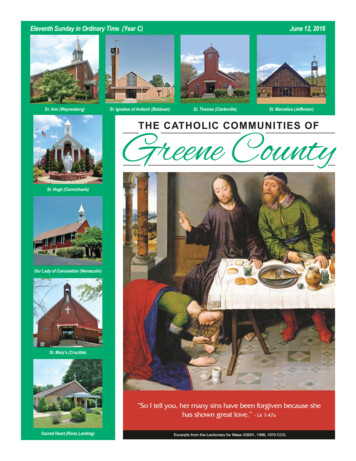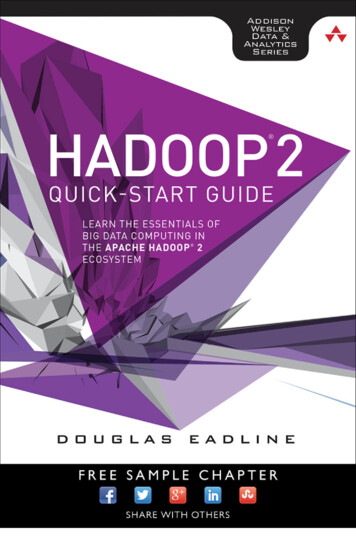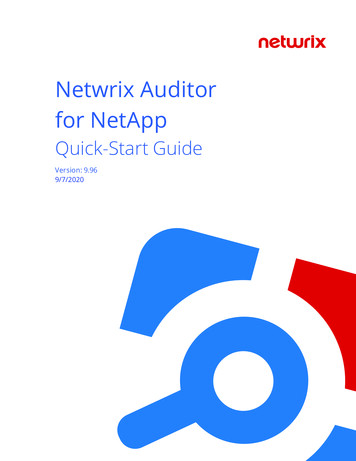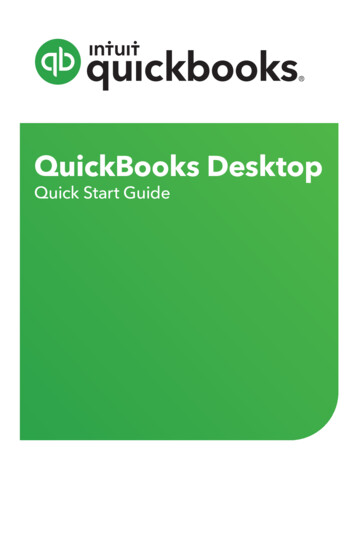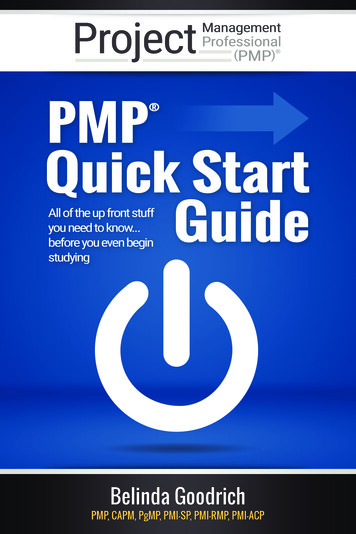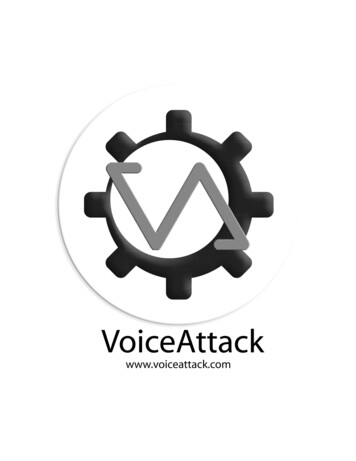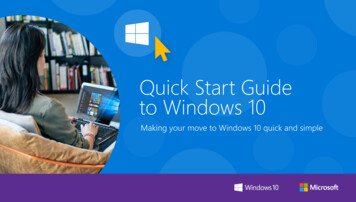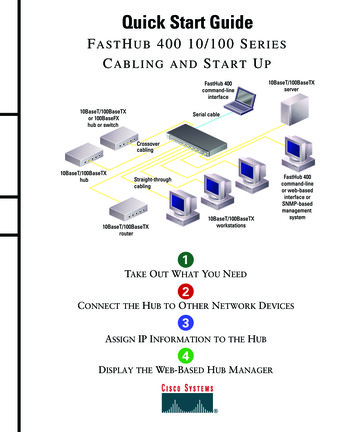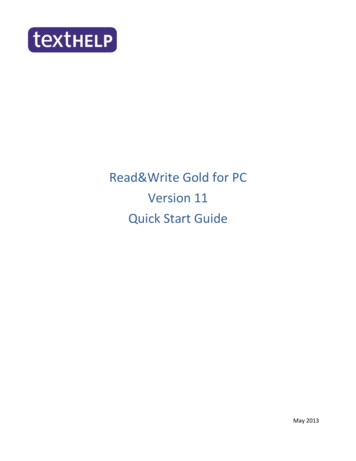
Transcription
Read&Write Gold for PCVersion 11Quick Start GuideMay 2013
Table of ContentsIntroduction . 3About Texthelp. 3About Read&Write Gold . 3Read&Write Gold Configurations . 3Training Options . 3Getting Started with Read&Write Gold . 4Getting Familiar with the Toolbar . 4Read&Write Gold Features . 4Reading Tools . 4Writing Tools . 6Research Tools . 8Study Skills Tools . 9Other Tools. 10Read&Write Gold Minimum System Requirements . 10Contact Us . 10
IntroductionAbout TexthelpTexthelp provides comprehensive literacy software solutions for individuals, K-12, higher education, andpublishers. Our Read&Write products are designed especially for individuals with reading and writingdifficulties, learning disabilities such as Dyslexia, or who are English Language Learners.The Read&Write family includes: Read&Write for the Desktop – Read&Write Gold for PC and Mac havecustomizable floating toolbars that provide support tools to be used withincommonly used Windows and Mac applications. Read&Write in the Cloud – Cloud offerings include Web Apps and Read&Writefor Google Docs. The Apps work in browsers to make web pages, Bookshare eBooks, and more accessible in the Cloud anytime, anywhere. Read&Write forGoogle Docs is a Chrome extension that makes Google documents accessible. Read&Write on the iPad – iReadWrite is an easy-to-use reading and writing Appthat runs directly on the iPad with no Wi-Fi or 3G needed.About Read&Write GoldRead&Write Gold helps all individuals succeed regardless of ability or learning style. Users of all agesaccess the reading, writing, studying, and research tools they need at school, home, or work. Thetoolbar seamlessly integrates with commonly-used applications including Microsoft Word, GoogleDocsTM, Mozilla Firefox , Internet Explorer , Google ChromeTM, and Adobe Reader to make digitalcontent accessible.Read&Write Gold ConfigurationsRead&Write Gold is delivered in two configurations: Read&Write Gold Download – Licensing options include single user, concurrent licenses, andunlimited site licenses for school and home use.Read&Write Gold Mobile – Single user license comes on a USB flash drive which allows users touse all of the features anywhere, anytime with no installation required.Read&Write Gold TrialWe are pleased to offer a 30-day trial so you can see for yourself how Read&Write Gold can helpreaders and writers succeed. We hope you find the examples included in this guide helpful as you tryand start using Read&Write Gold.All of the features of Read&Write Gold are available for 30 days following the initial install of the trialsoftware. Note: Only one text-to-speech voice (Ava) is included with the trial software.Training OptionsThere are several self-paced options available to help you learn more about Read&Write Gold. Online Help – To access Online Help, go to the Help menu available from the toolbar.Feature Videos – To access Read&Write Gold feature videos, go to the drop down menu next toeach feature on the toolbar or click on the arrow to the right of the Texthelp logo and go to “AllVideo Tours”. Note: By default, the videos are online and require an internet connection. Theycan also be downloaded and installed locally or accessed at www.texthelp.com.Manual and Training Guides – To download or view these guides, go ts/Readwrite/Downloads.Product Webinars – To see descriptions and schedules for our free product webinars, go binars.
Getting Started with Read&Write GoldGetting Familiar with the ToolbarThe default Read&Write Gold toolbar initially displays as follows:Online Help can be accessed from this menu by clicking on.By clicking on the down arrow to the right of the Texthelp logo you can choose from a list of task-specifictoolbars or customize your own. You can also click on the Texthelp logo to toggle through the availabletoolbars. Users can also customize the look of the toolbar and choose their preferred toolbar icon style.You can see additional feature icons by clicking on the double arrow to the left of the Texthelp logo.Note: To learn more, click on the arrow to the right of the Texthelp logo foradditional options and to watch the Toolbar video tour.Read&Write Gold FeaturesReading Tools – Text to Speech is one of the most fundamental support features of Read&Write Gold.Hearing text read aloud, using natural sounding male and female voices in conjunction withdual highlighting, helps the reader with comprehension and word recognition.Studies have also found that writing skills and attitude towards writing improve when writing is readaloud (Central Washington University, Technology for Learning Disabilities Project). To see this study aswell as additional research studies, go to .Read&Write Gold reading supports: Microsoft Word – Read text found in Word documents by word, sentence, paragraph, orcontinuously. Google Docs – Read text found in Google documents in Chrome. The Web – Read web pages in Internet Explorer, Chrome, and Firefox. Adobe Reader – Read PDF files. Inaccessible Flash and Text embedded in graphics – Read text that is typically inaccessible. Speak While Typing – Read written work aloud while typing. DAISY – Read DAISY books aloud. Includes support for MathML and Open University. NIMAS – Convert NIMAS files to reader-ready files through the NIMAS Conversion Tool.
To read a Word document, follow these steps:1) Open a Word document.2) Place the cursor on the text you would like to read.3) Click thebutton on the Read&Write Gold toolbar.4) To stop reading, click thebutton and to pause, click thebutton.5) To fast forward, click thebutton and to rewind, click thebutton.Note: To learn more, click on the arrow to the right of the Play icon for additional options and to watchthe Speech video tour.To read a Google Doc, follow these steps:1) Open a Google Doc from your Google Drive.2) Click thebutton to start reading the text. To stop reading, click thepause, click thebutton and tobutton.To read web content, follow these steps:1) Open a web page and select the text you would like to read.2) Click thebutton to start reading the text. To stop reading, click thepause, click thebutton and tobutton.3) Alternatively, click the down arrow besides thebutton and select ‘Read the web’. Hoverthe cursor over the text that you wish to have read aloud.To read a PDF file, follow these steps:1) Click on thebutton on the toolbar and open a PDF document that you would like toread.2) The PDF file will open but PDF Aloud will not automatically display if you are using Adobe Xor higher. Access the PDF Aloud Toolbar in Adobe X or XI, by clicking on Extended, then PDFaloud toolbar.Note: To learn more, click on the arrow to the right of the Texthelp logo and go to “All Video Tours” towatch the PDF Aloud video tour.To read inaccessible text (e.g., text embedded in an image, inaccessible Flash, or locked pdf) withScreenshot Reader, follow these steps:1) Click on thebutton.2) Surround the text that you would like to read. The text aloud will then be read aloud. Youcan also capture the text by drawing freehand around the text or by hovering over the text.3) Click on thebutton in the lower right corner to have the text read aloud again.4) To use Screenshot Reader to export the selected text to Word, click on the arrow to theright of thebutton and select “Screenshot to MS Word” before selecting text.Note: To learn more, click on the arrow to the right of the Screenshot Reader icon for additional optionsand to watch the Screenshot Reader video tour.
To hear text read aloud while typing, follow these steps:1) Open a Word document and click on the arrow to the right of the‘Speak as I Type’.2) You will hear the words read aloud as you type.3) Click on theits entirety.button and click onbutton when your written work is complete to read what you have written inWriting Tools – Read&Write Gold provides several tools to assist users with writing. These include:Phonetic Spell Checker – The advanced Phonetic Spell Checker analyzes and corrects spellingmistakes. Phonetic spelling errors as well as flexible spelling errors such as typing wordswithout vowels are identified. In addition, the Spell Checker uses collocated words (wordsthat precede or follow the error) to provide better suggestions.You can choose to spell check as you type or check your completed work. Spelling mistakes will beidentified and the Spell Checker window will provide a list of suggested corrections along with thedefinitions of each to aid in making the correct choice. Both the suggestions and the definitions can beread aloud.To try the Spell Checker, follow these steps:1) Open a new document and type “I would like to havebrkfst now.”2) Click on thebutton.3) The Spelling Helper panel appears with a list ofsuggestions and definitions.4) Click on “breakfast” in the suggestions list.5) Click on the definition and then click theThe meaning will be read aloud.6) Now click on thebutton.button to make the change.Note: To learn more, click on the arrow to the right of the Spell Checker icon for additional options andto watch the Spelling video tour.Dictionary – Talking dictionaries (basic, advanced, and online) are available to providedefinitions and alternative words to help expand vocabulary, improve readingcomprehension, and enhance creative writing skills.To try the Dictionary, follow these steps:1) Highlight a word in a document or web page and then click on thedialog box will open.2) Click on the definition you are interested in and click thesentences will be read aloud.button. The Dictionarybutton. The definition and sampleNote: To learn more, click on the arrow to the right of the Dictionary icon for additional options and towatch the Dictionary video tour.
Picture Dictionary – When you come across a word you are unsure of, you can search theonline picture dictionary for a visual image to better understand its meaning.To try the Picture Dictionary, follow these steps:1) Highlight a word in a Word document or web page and click on thebutton.2) The Picture Dictionary dialog box will open with any associated image(s). You can click the link tosee a text definition which can then be read aloud.3) If you double-click on an image, it will be placed in the Word document next to the associatedword. Adding images to documents benefits many users, especially those who requireaugmentative and alternative communication and English Language Learners.Note: To learn more, click on the arrow to the right of the Picture Dictionary icon for additional optionsand to watch the Picture Dictionary video tour.Sounds Like and Confusable Words Checker – Words that sound the same but are spelleddifferently (homophones) or words that are commonly confused are identified.To try the Sounds Like and Confusable Words Checker, follow these steps:1) Open a document and type “Your dog went threw the gate andleft his toy their.”2) Click on thebutton. The identified words will be indicated inblue and a dialog box will appear with alternate choices and theirdefinitions.Note: To learn more, click on the arrow to the right of the Sounds Like andConfusable Words icon for additional options and to watch the SoundsLike and Confusable Words video tour.Word Prediction – Word Prediction helps develop writing skills by providing tools to constructsentences with ease. It allows users to produce high quality work, lessens the time it takes forthem to do so, and reduces keystrokes for those with diminished physical dexterity.Word Prediction completes words being typed and suggests words to use next. The Prediction databaseincludes over 1 million of the most common phrases used in spoken English, fiction, non-fiction, popularmagazines, newspapers, and academic texts. In addition, 150 subject-specific Word Banks are included.Users can also add their own Words and Word Banks. Word Prediction also uses the phonetic mappingsfound in the Spell Checker to provide even more suggestions. Sounds like and confusable words areidentified and definitions are available when working within the Prediction Panel.To try Word Prediction, follow these steps:1) Click on thebutton.2) Open a new document and type “Do you use Face3) The Prediction Panel will be populated with suggestions for completing the nextword.4) To insert any word from the Panel, click on the word or use the correspondingFunction key.Note: To learn more, click on the arrow to the right of the Prediction icon for additionaloptions and to watch the Prediction video tour.
Research Tools – Read&Write Gold provides several tools to assist while doing research for classassignments. These include:Fact Finder helps find information quickly by searching the web for relevant information abouta topic.To try Fact Finder, follow these steps:1) Click on thebutton.2) Type “Sharks” in the Manual Text Search Box and click OK.3) Fact Finder opens a browser window and displays search results for “Sharks” using the defaultsearch engine.Note: To learn more, click on the arrow to the right of the Fact Finder icon for additional options and towatch the Fact Finder video tour.Fact Folder helps prepare and store information for research assignments or when writingreports.To try Fact Folder, follow these steps:1) Open Internet Explorer and select a fact and click on thebutton.The Fact Details Panel will appear.2) Notice how the Title, Date, Author, and Source fields have been filledin automatically. You can alter these by clicking in each box andediting as required.3) Click OK. A message will appear saying that a fact has been added.4) Click on the arrow next to thebutton or click on the Fact Foldermenu item and select Add Web Image. Hover your mouse over apicture on the web page and click on it to capture the image.5) The Fact Details panel will appear assigning the default name “MyPicture 1”. Edit Title, Date, and details as appropriate.6) Click OK. A message will appear saying that a fact has been added.7) Click on the arrow next to thebutton or click on the Fact Folder menu item and selectReview Facts. Fact Folder opens with the information you have added. You can now add morefacts, delete a fact, or export your facts to a Word document.Note: To learn more, click on the arrow to the right of the Fact Folder icon for additional options and towatch the Fact Folder video tour.Fact Mapper produces a visual representation of facts and ideas on screen. This is useful whenbrainstorming and revising work. With Fact Mapper, you can use images and color to helpremember key facts, brainstorm ideas, and outline key concepts when creating drafts.Note: To learn more, click on the Fact Mapper icon and go to Help to watch the Fact Mapper video tour.
Study Skills Tools – When reading documents, books, or journals, users often use colored markers tohighlight portions of text which are relevant to the subject they are studying or researching. Study Skillstools promote active learning and help engage readers of all ages.The Study Skills Highlighters can be used to highlight and extract textfrom any document or web page to create study guides and outlines.This is especially useful when you want to select text and categorize it separately by type (e.g., mainideas in pink, supporting details in blue, vocabulary words in green, etc.). Highlights can then becollected from a single source or from multiple open documents or web pages and exported, withsource citations, into a single document. This makes it easy to complete an assignment, start an outline,or create a study guide.To try the Study Skills Highlighters, follow these steps:1) Access Study Skills by clicking on the Texthelp button on the toolbar until you see the StudySkills Features toolbar.2) Open a document or web page.3) Select text and click on thebutton. The text will be highlighted in yellow.4) Select new text from another document or web page and click on thebe highlighted in pink.button. The text will5) Click on the Collect Highlights button. The Collect Highlights window is displayed.6) Choose your output selection from the various options and settings available, including orderinghighlights by color, collection time, or position in document.7) Click on the OK button. The highlighted text will now be inserted into a new document.Note: To learn more, click on the arrow to the right of the Collect Highlights icon for additionaloptions and to watch the Study Skills video tour.The Vocabulary List Builder takes words highlighted in a Word or Google document or a webpage using the Study Skills Highlighters, or words entered manually and creates a VocabularyList document. This new document contains a table with the words, dictionary definitions foreach, and images. This tool gives both students and teachers a quick and easy way to create avocabulary list to help improve and expand vocabulary skills. For strategies on using theVocabulary Builder, go towww.texthelp.com/media/163964/vocabulary list builder for new words.mp4.To try the Vocabulary List Builder, follow these steps:1) Use the Study Skills Highlighters to highlight several words in a document or web page and clickon thebutton.2) A Vocabulary dialog box will open with the highlighted words that you have chosen in theVocabulary List.3) Add additional words and a title if you choose, then click OK. A document will automatically becreated with the words as well as definitions and images for each word.Note: To learn more, click on the arrow to the right of the Texthelp logo and go to “All Video Tours” towatch the Vocabulary List Builder video tour.
Other Tools – In addition to the tools featured in this Quick Start Guide, there are many other powerfulsupport tools in Read&Write Gold, including: Word Cloud – Use Word Banks or selected text to create and display wor
Includes support for MathML and Open University. NIMAS – Convert NIMAS files to reader-ready files through the NIMAS Conversion Tool. Note: To learn more, click on the arrow to the right of the Texthelp logo fo

